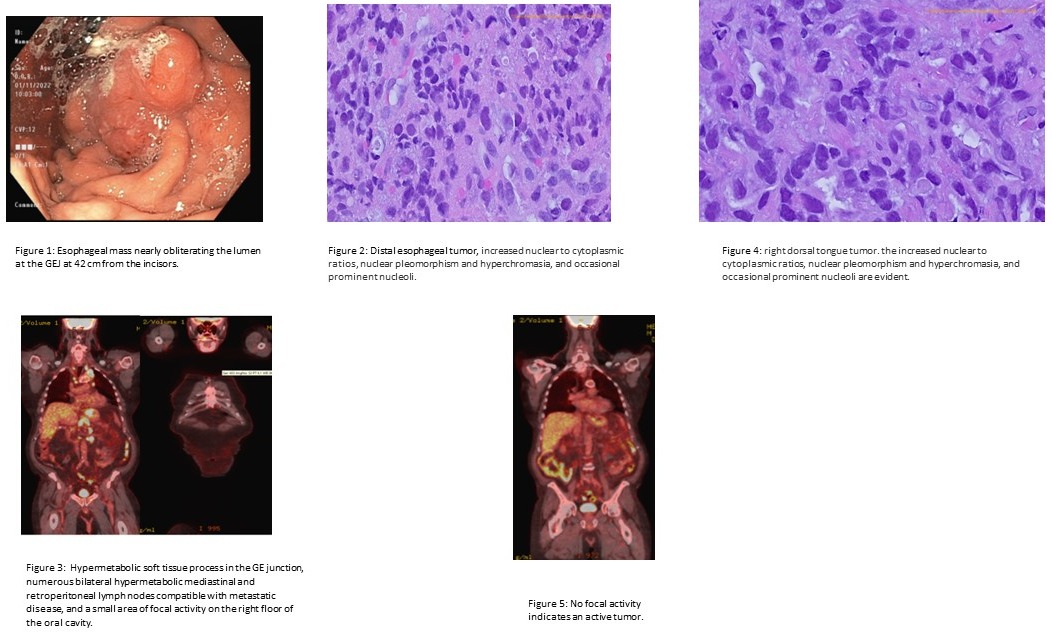Back
Poster Session A - Sunday Afternoon
A0216 - Gastroesophageal Junction Adenocarcinoma With Metastases to the Dorsum of the Tongue: A Rare Case Report
Sunday, October 23, 2022
5:00 PM – 7:00 PM ET
Location: Crown Ballroom

Ahmad Abulawi, MBBS
Albany Medical College
Albany, NY
Presenting Author(s)
Ahmad Abulawi, MBBS1, Amin Azem, MBBS1, Ibrahim Khatim, MBBS1, Raya Al-Ashram, MBBS2, Allison Lupinetti, MD3, Lezah McCarth, MD3, Syed Mehdi, MBBS4
1Albany Medical College, Albany, NY; 2KHCC, Albany, NY; 3Albany Stratton VA Hospital, Albany, NY; 4Albany Stratton VA Medical Center, Albany, NY
Introduction: Gastroesophageal Junction (GEJ) cancer is an invasive disease with a poor prognosis and commonly presents at an advanced stage. Metastases of GEJ cancer are most frequently seen in the lung, liver, and distant lymph nodes. Here, we are reporting for the first time in the literature metastatic GEJ adenocarcinoma (AC) to the oral cavity.
Case Description/Methods: A-72-year-old male presented with severe dysphagia to solids and liquids, and weight loss for 1 month. Evaluation with upper endoscopy revealed a tumor nearly obliterating the lumen at the GEJ, 42 cm from the incisors (Figure 1). Biopsy confirmed the diagnosis of AC of the GEJ (Figure2), and genetic testing showed: MSI: Stable, PDL 1%, and HER-2: negative. The patient was evaluated further Positron emission tomography (PET) scan which showed a hypermetabolic soft tissue process in the GEJ, numerous bilateral hypermetabolic mediastinal and retroperitoneal lymph nodes, and interestingly a small area of focal activity on the right floor of the mouth (Figure 3). Biopsy of the tongue lesion confirmed stage IV AC of GEJ origin (Figure 4). The case was then discussed in our multidisciplinary tumor board. The decision was to proceed as per NCCN guidelines with palliative radiation therapy (RT) for severe dysphagia and sequentially FOLFOX (5-fluorouracil, leucovorin, and oxaliplatin) chemotherapy, the patient did not receive immunotherapy as his PD-L1 is 1%. PET scan after completion of radiotherapy and 5 cycles of FOLFOX showed no evidence of disease (Figure 5).
Discussion: GEJ cancer is a devastating disease that commonly presents at an advanced stage and bears a dismal prognosis. The metastatic pattern of this disease frequently involves the liver, lung, distant lymph nodes, peritoneum, and bone. Studies have shown two major differences in the metastatic pattern according to the histological subtype; AC tends to metastasize to the liver, peritoneum, and bone. Whereas squamous cell carcinoma most commonly metastasizes to the lungs. However, the overlap between both categories exists. To the best of our knowledge, we are reporting for the first time in the literature GEJ AC with metastasis to the oral cavity. Management of patients with advanced, unresectable GEJ cancer represents a challenging scenario. External beam radiation therapy with concurrent chemotherapy is the standard approach for patients with unresectable disease. Our patient had a wonderful response both clinically and radiologically with negative follow-up FDG PET.

Disclosures:
Ahmad Abulawi, MBBS1, Amin Azem, MBBS1, Ibrahim Khatim, MBBS1, Raya Al-Ashram, MBBS2, Allison Lupinetti, MD3, Lezah McCarth, MD3, Syed Mehdi, MBBS4. A0216 - Gastroesophageal Junction Adenocarcinoma With Metastases to the Dorsum of the Tongue: A Rare Case Report, ACG 2022 Annual Scientific Meeting Abstracts. Charlotte, NC: American College of Gastroenterology.
1Albany Medical College, Albany, NY; 2KHCC, Albany, NY; 3Albany Stratton VA Hospital, Albany, NY; 4Albany Stratton VA Medical Center, Albany, NY
Introduction: Gastroesophageal Junction (GEJ) cancer is an invasive disease with a poor prognosis and commonly presents at an advanced stage. Metastases of GEJ cancer are most frequently seen in the lung, liver, and distant lymph nodes. Here, we are reporting for the first time in the literature metastatic GEJ adenocarcinoma (AC) to the oral cavity.
Case Description/Methods: A-72-year-old male presented with severe dysphagia to solids and liquids, and weight loss for 1 month. Evaluation with upper endoscopy revealed a tumor nearly obliterating the lumen at the GEJ, 42 cm from the incisors (Figure 1). Biopsy confirmed the diagnosis of AC of the GEJ (Figure2), and genetic testing showed: MSI: Stable, PDL 1%, and HER-2: negative. The patient was evaluated further Positron emission tomography (PET) scan which showed a hypermetabolic soft tissue process in the GEJ, numerous bilateral hypermetabolic mediastinal and retroperitoneal lymph nodes, and interestingly a small area of focal activity on the right floor of the mouth (Figure 3). Biopsy of the tongue lesion confirmed stage IV AC of GEJ origin (Figure 4). The case was then discussed in our multidisciplinary tumor board. The decision was to proceed as per NCCN guidelines with palliative radiation therapy (RT) for severe dysphagia and sequentially FOLFOX (5-fluorouracil, leucovorin, and oxaliplatin) chemotherapy, the patient did not receive immunotherapy as his PD-L1 is 1%. PET scan after completion of radiotherapy and 5 cycles of FOLFOX showed no evidence of disease (Figure 5).
Discussion: GEJ cancer is a devastating disease that commonly presents at an advanced stage and bears a dismal prognosis. The metastatic pattern of this disease frequently involves the liver, lung, distant lymph nodes, peritoneum, and bone. Studies have shown two major differences in the metastatic pattern according to the histological subtype; AC tends to metastasize to the liver, peritoneum, and bone. Whereas squamous cell carcinoma most commonly metastasizes to the lungs. However, the overlap between both categories exists. To the best of our knowledge, we are reporting for the first time in the literature GEJ AC with metastasis to the oral cavity. Management of patients with advanced, unresectable GEJ cancer represents a challenging scenario. External beam radiation therapy with concurrent chemotherapy is the standard approach for patients with unresectable disease. Our patient had a wonderful response both clinically and radiologically with negative follow-up FDG PET.

Figure: Figures 1-5
Disclosures:
Ahmad Abulawi indicated no relevant financial relationships.
Amin Azem indicated no relevant financial relationships.
Ibrahim Khatim indicated no relevant financial relationships.
Raya Al-Ashram indicated no relevant financial relationships.
Allison Lupinetti indicated no relevant financial relationships.
Lezah McCarth indicated no relevant financial relationships.
Syed Mehdi indicated no relevant financial relationships.
Ahmad Abulawi, MBBS1, Amin Azem, MBBS1, Ibrahim Khatim, MBBS1, Raya Al-Ashram, MBBS2, Allison Lupinetti, MD3, Lezah McCarth, MD3, Syed Mehdi, MBBS4. A0216 - Gastroesophageal Junction Adenocarcinoma With Metastases to the Dorsum of the Tongue: A Rare Case Report, ACG 2022 Annual Scientific Meeting Abstracts. Charlotte, NC: American College of Gastroenterology.
